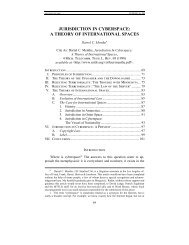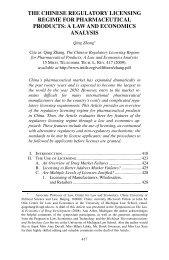Fracking Patents - Michigan Telecommunications and Technology ...
Fracking Patents - Michigan Telecommunications and Technology ...
Fracking Patents - Michigan Telecommunications and Technology ...
- No tags were found...
You also want an ePaper? Increase the reach of your titles
YUMPU automatically turns print PDFs into web optimized ePapers that Google loves.
Spring 2013] <strong>Fracking</strong> <strong>Patents</strong> 323guaranteed. Legislative reform faces constitutional obstacles that render itineffective in the short term. Doctrinal reform is discretionary, <strong>and</strong> the judiciaryhas not shown any inclination to revisit experimental use since Madey.If there is a ray of hope, it is the fact that patent exclusion is not automatic.The nature of the litigation process, as well as the likely defendantsinvolved, provide some flexibility for retaining information flow. Beforeoverreacting to patent obstacles, it is important to appreciate current options<strong>and</strong> identify the actors with flexibility. In the end, creating awareness of theproblem of patent restriction will likely be the most effective means of ensuringthat the threat of strong patents does not encumber necessaryresearch.A. Legislative Revision of Rights Is Direct but Faces ObstaclesCongress has the power to create an exception for experimental uses thatwould cover safety investigations, quality assurance or even competitor research<strong>and</strong> development. Such an exception would not need to be justified as“non-commercial” to be enforceable, but could serve any purpose related topromoting the progress of the useful arts. 299 This is essentially what occurredin 1984 with the passage of the Hatch-Waxman Act, creating rules for pharmaceuticalregulation that included a research exception for submissions tothe FDA. 300 This limitation on rights is known as the Bolar exemption inreference to its overruling of a Federal Circuit case, Roche Products, Inc. v.Bolar Pharmaceutical Co. that found no infringement relief for clinical testingin preparation for generic drug applications. 301 The rule is facially commercialin furtherance of its public mission. Essentially, Congress created anexception to permit generic pharmaceutical companies to have an approveddrug ready to market as soon as the patent expires. 302 This reduces patentowner profitability <strong>and</strong> creates a more favorable environment for competitors,but it does so for an important social goal. The Bolar exception doesnot affect patentability; rather, it simply carves out part of the patent owner’senforcement rights.Similarly, in 1996 an exception was enacted that limited the enforcementof patents on surgical procedures. 303 The exception was specifically299. The courts have generally given Congress great freedom to craft law under the Constitution’sintellectual property clause, U.S. CONST. art. I, § 8, cl. 8, even if the innovationbenefits are not clear. See Golan v. Holder, 132 S. Ct. 873, 889 (2012) (detailing the deferenceCongress must receive related to the copyright aspects of the intellectual property clause).Thus, the argument that a particular exemption is unconstitutional because it is too broad orreduces inventions incentives is not viable.300. 35 U.S.C. § 271(e) (2011).301. Roche Products, Inc. v. Bolar Pharm. Co., Inc., 733 F.2d 858, 863 (Fed. Cir. 1984).302. See Gerald J. Mossinghoff, Overview of the Hatch-Waxman Act <strong>and</strong> Its Impact onthe Drug Development Process, 54 FOOD & DRUG L.J. 187, 190 (1999) (describing the intentof the law to overrule Bolar <strong>and</strong> its impact on the regulatory system).303. 35 U.S.C. § 287(c) (2011).






